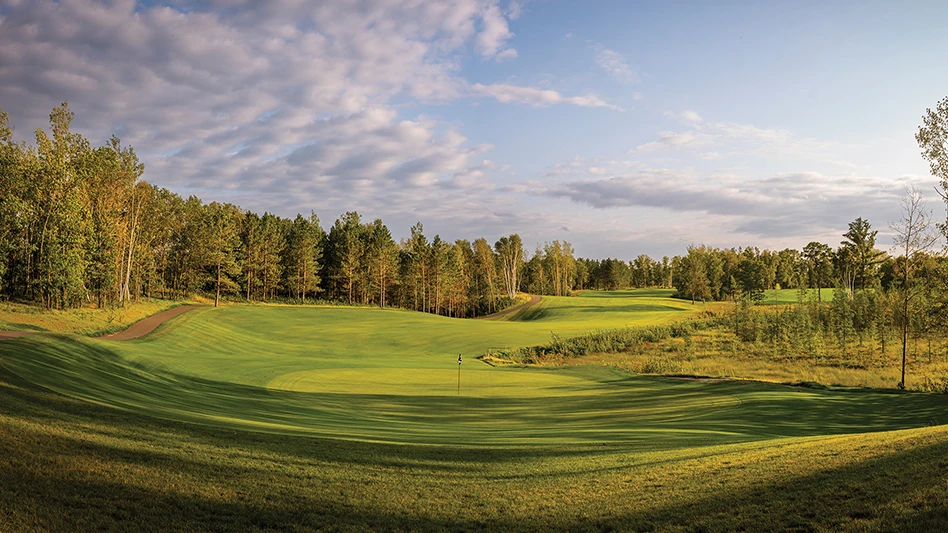

Matt McKinnon’s job as the Cragun’s Legacy Courses director of golf course maintenance means he works within a playground.
The section of the playground he oversees traverses rolling land. Pines extend into the sky. Wetlands help frame turf. Sand and peat rest beneath the surface.
The soon-to-be 54-hole Cragun’s Legacy Courses are an amenity offered by Cragun’s Resort on Gull Lake, a cozy, woodsy and folksy destination in Brainerd, Minnesota. Brainerd is 130 miles from the Twin Cities, a major metropolitan area Minnesotans affectionately call “The Cities.” When people from “The Cities” want to play for a few days, the compass often points north toward Brainerd.
Boating. Fishing. Swimming. Paddling. Golf. Hiking. Hunting. Snowmobiling. Skiing. Star gazing.
Slow down for a few days. Return to “The Cities.”
Golf fits snuggly into the playground from mid-April until mid-October. Because resorts are big business and because playgrounds are reimagined as eras and tastes progress, McKinnon is involved with the Midwest’s largest public and resort golf renovation.
His life has included more work than play since Cragun’s embarked on a multi-year renovation in 2021. Scheduled for completion in late 2024, the project will give the resort 36 renovated regulation holes and nine new holes. The nine new holes, part of the Lehman 18, opened this summer. The Dutch 18 will become the Dutch 27 next year.

Tight construction windows accompany a climate that compacts the golf season. And business doesn’t always halt when the bosses seek progress. Through three seasons of dirt and disruption, the resort has kept 27 holes open at nearly all times
Deadlines and digging have consumed McKinnon’s life since 2021.
“When you put a deadline on something, that’s a challenge,” he says on a mid-summer afternoon following his first opportunity to play the fully opened Lehman 18. “And to go from dirt to playable and people love it, that’s another challenge. At the end of a day, you can hardly keep your eyes open. But that challenge drives me.”
Dozens of others have experienced the same fatigue and satisfaction accompanying the $17 million renovation in the middle of Minnesota. The team surrounding McKinnon to rebuild the golf portion of the Cragun’s playground understands the whims and wonder of Minnesota, where 89 percent of the state’s 422 courses are public facilities, according to the National Golf Foundation.
The abundance of Paul Bunyan statues, sites, and references inside and around Brainerd offers evidence that Minnesotans appreciate folklore. A statue of Bunyan slinging an axe over his right shoulder and bending his left leg on a tree stump next to Babe the Blue Ox greets visitors upon entering Cragun’s Resort. The resort grounds and golf courses are separated by 1.8 miles. There are no Bunyan statues at the golf courses, although a popular multi-use recreational trail in the region is named for the hulking character.
The story behind the Cragun’s renovation begins with a conversation between two real people who are key figures in Minnesota sports and tourism history.
During the summer of 2020, Tom Lehman, a Minnesotan whose Bunyanian feat involved winning the 1996 Open Championship, visited Brainerd to watch his son Sean compete in the Minnesota PGA Junior Match Play Championship on the Cragun’s Dutch Legacy Course. A mutual acquaintance introduced Lehman to Cragun’s owner Merrill “Dutch” Cragun Jr., whose Bunyanian feat involves transforming the family business into a playground destination for denizens of “The Cities” and elsewhere. Cragun asked Lehman his opinion of the golf courses, a pair of late 1990s Robert Trent Jones Jr. designs.
Two months later, Lehman, a dabbler in golf architecture projects throughout the last 25 years, returned to Brainerd with design partner Chris Brands. The pair presented ideas to expand and enhance the Cragun’s Legacy Courses, which rest on a 1,000-acre parcel consisting of wetlands and woods with enough elevation change and extended views to support fascinating golf. A touring pro/designer who describes himself as a “one-project-at-a-time” architect, Lehman had suddenly obtained one of the biggest golf construction projects anywhere. Besides it being a Minnesota effort, Lehman says a solid original routing, “beautiful” land and supportive ownership attracted him to the project.
Cragun’s officials viewed a relationship with Lehman as a method to gain separation in a competitive golf market. The Brainerd region features more than 450 resort and daily-fee golf holes while the addition of multiple high-profile facilities and courses in the last 20 years has transformed bordering Wisconsin into a major golf tourism destination.
“We had a great facility, but the other great courses in Brainerd came to market just before Cragun’s did,” Cragun’s Resort general manager Eric Peterson says. “We kind of lacked a little bit of that notoriety. And we were 20-plus years old, so things like the bunkers were in need of renovation. We asked ourselves: Do we do an incremental renovation? Or do we take this opportunity with Tom to make a big splash and set the golf course complex up for the next 25 years?”
Construction commenced in April 2021 when a crew from Duininck Golf mobilized in Brainerd. Landing the Cragun’s project represented a major triumph. Not only did the renovation offer multiple years of work, but it represented a home effort for the Minnesota-based company. The work at Cragun’s is a rare example of a major golf construction project featuring an architect and builder with in-state roots. “It’s really something that hit home for us,” says Duininck Golf project superintendent Jacob Cooper, a Hastings native who played college golf at Minnesota State Mankato.
The only piece of the core renovation team not genetically linked to Minnesota happened to be the person who knows the land better than anybody.
A native of neighboring North Dakota, McKinnon moved to Minnesota in 1995 to work as an assistant superintendent at Bemidji Town & Country Club. He arrived at Cragun’s in March 1998, seven months after construction commenced on the first Jones-designed course. The resort had 45 holes open, including a reversible, 9-hole, par-3 course across East Gull Lake Drive from the regulation layouts, by 2002. “It was all dirt when I came here and only 18 holes had been shaped and probably only three-quarters of them had irrigation,” McKinnon says. “Nothing had been seeded yet.”
Construction continued in some form until 2007, as multiple tweaks to the original design made the course more playable for golfers of varying skill levels. From 2008 until the 2020 discussions with Lehman, McKinnon’s team operated in maintenance mode. “Here we are, in a very short period of time with a new golf course again,” McKinnon says.
Contrasting courses are the result of Cragun’s second golf life.
The Lehman 18 blends existing holes routed around Stephens Lake with nine new holes: Nos. 4-8 and 10-13. New homes will border eight of the nine new holes. The new par 4s and 5s sit atop sand, possess elevation, and are routed through scraggly pines. Wetlands border the new par 3s, Nos. 6 and 12. Tree clearing on No. 6 opened a view of a pond with a beaver lodge behind the green. Lehman calls the wetland traversing trek between 12th green and 13th tee “probably the most scenic cart path in Minnesota.”
Holes on natural sand — a rarity for the Upper Midwest — offered a tremendous design and construction asset. “That’s really unique to this lakes area,” says Duininck Golf division manager Judd Duininck. “It’s either sand or peat, you don’t have much in between for soils.”
The presence of sand allowed Lehman to design holes promoting a style of golf he relishes. The architect, after all, experienced his greatest golf moment on a links course. The bunkers on the Lehman 18 feature revetted faces, a visual and playability contrast to the grass faces on the Dutch 27. The Lehman 18 also has wider fairways and a more open feel due to fewer trees.
“It’s a different look,” Lehman says of the course named for him. “It ends up being way more fairway, way more cut grass, firmer, let the ball run, with a more dramatic looking bunker face. We have two very distinct golf courses. They play differently and they look different, which is what we were aiming for.”
Sand expedited construction, especially during soggy stretches. “The best part of the sand is how fast you can move it and shape it and put it into place,” Cooper says. “If there are any changes, it’s something we are able to do and move around pretty easily.”
But holes atop sand can also bring new maintenance considerations as McKinnon and his team attempt to balance playability challenges attached to firmness sought by elite players with the masses seeking pleasant aesthetics. “We’re a resort golf course,” McKinnon says. “What do people want to come here and see? Green grass, wonderful green trees, everything green. I think we can manage firm conditions for the most part, especially if we get some rain to balance things out.”
McKinnon and his team, which peaked at 43 workers this past summer, will encounter more maintenance in some areas and less in others when the project concludes with the unveiling of the Red 9 on the Dutch 27 in 2024. Fairways will be slightly more than 100 acres and tees will be around seven acres for 45 holes. Both acreages are increases. Total green surface will decrease to around seven acres despite nine more holes. The courses will combine to include around 151,000 square feet of bunker surface, a 45 percent decrease from the previous layouts.
“How can you not be proud of the bunkers now?” McKinnon says. “They are brand new with white sand. We hand rake them every day. It’s more work than just jumping on a machine, but they are higher quality.”
New turf varieties are covering the renovated playing surfaces. More than 90 percent of the regrassing effort involved seeding greens, fairways and tees, according to McKinnon. Greens were converted from Providence creeping bentgrass to Dominant X-treme 7 creeping bentgrass, fairways from Providence to 007/Flagstick and tees from Penncross to 007/Flagstick. A few areas were sodded to hit hole opening deadlines.
McKinnon has a pair of course superintendents — Ken Anderson on the Dutch 27 and Bob Wekenman on the Lehman 18 — but he remains a hands-on director. Throughout the project, he has walk mowed newly seeded greens. “If you don’t see it every day, it’s hard to manage,” he says. “That’s the way I like to do things, I like to see it every day.” McKinnon walked mowed the first newly seeded green on June 5, 2021. The final green will be seeded this fall.
Cragun’s reached a project milestone this past summer when it went from 27 to 36 open regulation holes. Maintenance efficiencies such as deploying triplexes on greens once turf matures and adopting an aggressive plant growth regulator program to limit fairway mowing to twice per week on each course help McKinnon’s team juggle construction and grow-in duties with preparing the courses for daily play.
Consecutive summers of major construction and establishing new turf is a rarity even in a highly active golf construction market. Past experience suggests the grind will continue once the Lehman and Duininck teams leave.
“Until it’s all grown in where it can sustain itself, it’s going to be a never-ending deal,” McKinnon says. “You don’t know it until it happens. You can’t put a timeline on it completely.”


Explore the October 2023 Issue
Check out more from this issue and find your next story to read.
Latest from Golf Course Industry
- From the publisher’s pen: Conscientious of a bigger role
- Bernhard and Company partners with Laguna Golf Phuket
- Terre Blanche showcases environmental stewardship
- VIDEO: Introducing our December issue
- Bernhard and Company introduces Soil Scout
- Nu-Pipe donates to GCSAA Foundation’s Centennial Campaign
- GCSAA enhances golf course BMP tool
- Melrose leadership programs sending 18 to 2026 GCSAA Conference and Trade Show





